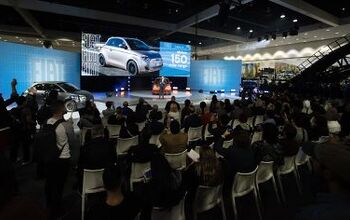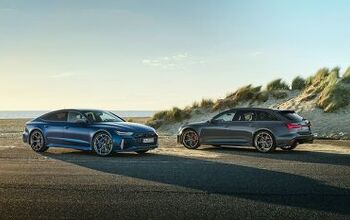Ghosn Expects Renault-Nissan to Become World's Largest Automaker This Summer

Since acquiring Mitsubishi in 2016, the Renault-Nissan Alliance has found itself in the midst of Volkswagen and Toyota’s struggle for the title of World’s Largest Automaker.
At the end of 2016, VW was still on top but momentarily ceded ground as Toyota amped up volume in early 2017. Compared to last year, the Germans saw sales fall a half-percent in the first quarter of 2017 as the Japanese companies recorded more stable growth. But CEO extraordinaire Carlos Ghosn believes Renault-Nissan has what it takes to fill the top spot before the end of the summer.
While it would be a privilege to tell you that Ghosn entered a darkened room illuminated by a single spotlight to announce the time for the Alliance to crush its enemies was now, the reality was far more tame. The shareholders meeting was adequately lit and Carlos stated, without malice, that becoming the world’s largest automotive superpower is more of an inevitable accident than an intentional conquest.
“We have been among the top three carmakers since January in sales volume, and we expect to be in the top spot by midyear — although this was not our goal,” Ghosn announced to shareholders at Renault’s annual meeting last week.
Current estimates have Volkswagen back in the lead. Market research company JATO Dynamics, which uses a combo of vehicle registrations and retail sales futures, surmises VW Group has sold 3.32 million vehicles, Toyota 3.06 million and Renault-Nissan 3.02 million.
Felipe Munoz, a global automotive analyst at JATO, told Automotive News it wasn’t a guarantee the Renault-Nissan Alliance hit number one in 2017 but it is definitely on the path. “[Renault-Nissan] is pointing in the right direction in many ways,” Munoz said, “They are managing their brands very well. Where Renault is weak, Nissan is strong, and vice versa.”
Growth is they key factor in how quickly the alliance makes ground. Renault-Nissan was already progressing nicely prior to the acquisition of Mitsubishi. All of its brands have seen an overall growth on the global stage as Volkswagen shrinks and it has a more diverse portfolio than Toyota — the cornerstone of which are SUVs, which do well in both established and emerging markets.
However, the alliance isn’t pursuing volume for its own satisfaction. More sales means more incentive to get strategic help from suppliers. Monster production output in places like Russia for AvtoVAZ means better deals for lower-volume brands like Automobile Dacia.
“If we can go to our suppliers and say, we are no longer asking for 100,000 or 200,000 parts, but we are asking for 400,000 parts because we are bringing in the AvtoVAZ volume,” Jérémie Papin, an alliance director responsible for business development, said in an Automotive News interview earlier this year. “The prices that we get are meaningfully different on what is still 70 percent of the cost of a car.”
[Image: Nissan]

A staunch consumer advocate tracking industry trends and regulation. Before joining TTAC, Matt spent a decade working for marketing and research firms based in NYC. Clients included several of the world’s largest automakers, global tire brands, and aftermarket part suppliers. Dissatisfied with the corporate world and resentful of having to wear suits everyday, he pivoted to writing about cars. Since then, that man has become an ardent supporter of the right-to-repair movement, been interviewed on the auto industry by national radio broadcasts, driven more rental cars than anyone ever should, participated in amateur rallying events, and received the requisite minimum training as sanctioned by the SCCA. Handy with a wrench, Matt grew up surrounded by Detroit auto workers and managed to get a pizza delivery job before he was legally eligible. He later found himself driving box trucks through Manhattan, guaranteeing future sympathy for actual truckers. He continues to conduct research pertaining to the automotive sector as an independent contractor and has since moved back to his native Michigan, closer to where the cars are born. A contrarian, Matt claims to prefer understeer — stating that front and all-wheel drive vehicles cater best to his driving style.
More by Matt Posky
Latest Car Reviews
Read moreLatest Product Reviews
Read moreRecent Comments
- Analoggrotto Does anyone seriously listen to this?
- Thomas Same here....but keep in mind that EVs are already much more efficient than ICE vehicles. They need to catch up in all the other areas you mentioned.
- Analoggrotto It's great to see TTAC kicking up the best for their #1 corporate sponsor. Keep up the good work guys.
- John66ny Title about self driving cars, linked podcast about headlight restoration. Some relationship?
- Jeff JMII--If I did not get my Maverick my next choice was a Santa Cruz. They are different but then they are both compact pickups the only real compact pickups on the market. I am glad to hear that the Santa Cruz will have knobs and buttons on it for 2025 it would be good if they offered a hybrid as well. When I looked at both trucks it was less about brand loyalty and more about price, size, and features. I have owned 2 gm made trucks in the past and liked both but gm does not make a true compact truck and neither does Ram, Toyota, or Nissan. The Maverick was the only Ford product that I wanted. If I wanted a larger truck I would have kept either my 99 S-10 extended cab with a 2.2 I-4 5 speed or my 08 Isuzu I-370 4 x 4 with the 3.7 I-5, tow package, heated leather seats, and other niceties and it road like a luxury vehicle. I believe the demand is there for other manufacturers to make compact pickups. The proposed hybrid Toyota Stout would be a great truck. Subaru has experience making small trucks and they could make a very competitive compact truck and Subaru has a great all wheel drive system. Chevy has a great compact pickup offered in South America called the Montana which gm could make in North America and offered in the US and Canada. Ram has a great little compact truck offered in South America as well. Compact trucks are a great vehicle for those who want an open bed for hauling but what a smaller more affordable efficient practical vehicle.


































Comments
Join the conversation
Nissan's vehicles may be boring to some, some people may hate the fact that Nissan's CVTs don't have shift shock or shift time lag like traditional transmissions or some may not like the amount of plastic in their interiors; however, their sales continue to go up and up. Apparently this is a car company that builds what the consumer wants. Data does not lie. I'm completely impressed with what this company has done and the direction it is headed in. Their leadership team, along with their employees on the shop floor have to be kicking butt and taking names to have achieved this volume and position in an extremely competitive market. I hope they enjoy the ride! They have all earned it.
It looks as if GM is going to drop to 4th place. It is time for Bara to go. The company is a national embarrassment.